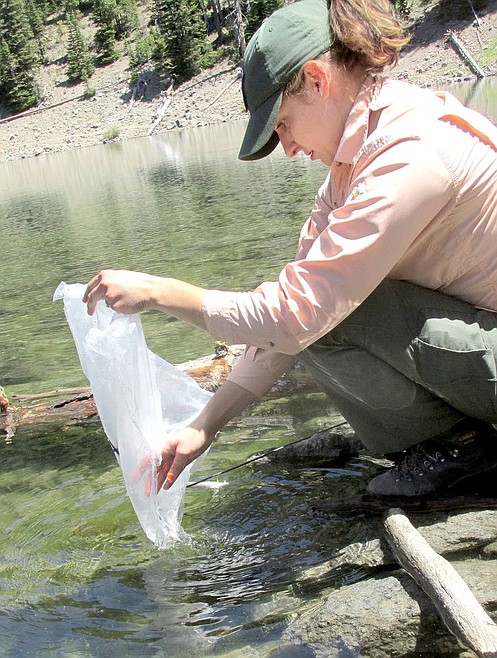Backcountry hiking with fish in a bag
Like an anxious family gathered around the tree on Christmas morning, several Idaho Fish and Game employees stood next to a pickup truck at the Sage Junction rest stop on Interstate 15 one recent morning, waiting for their package.
The packages were pillow-sized, water-tight plastic bags, each with about a gallon of water inside and 500 finger-length Yellowstone cutthroat trout.
Jason Jones, from the Mackay Fish Hatchery, met up with Fish and Game workers from the Upper Snake Region at the rest stop with several large coolers partially filled with ice and nine bags of tiny fish. Besides the water, each bag was filled with pure oxygen to tide the fish over until they arrived at their new homes.
Like a postal address, each bag was marked with a specific alpine lake destination: Salamander, Aldous, Hancock, Pass Creek and Packsaddle. The bags were carefully placed in coolers in the back of pickups and more ice was dumped inside. Some lakes were two-baggers — 1,000 fingerlings. The lakes range in size from about 2 acres to about 5 acres.
Because there are no roads to the lakes, all would be carried up inside large backpacks, except for Pass Creek Lake. One bag per backpack. The trail to Pass Creek Lake allows ATVs, so fisheries biologist Pat Kennedy drove his two bags up on the back of an ATV.
The operation was under the direction of Brett High, Upper Snake Region’s fisheries manager.
He outlined the day’s activity. Workers would drive to the trailheads in ones and twos, and pack their fish to the lakes. Some lakes were farther up the trail than others. The fish bags would sit in the lake water for about an hour to become acclimated, then the bags would be cut open and spilled into the lake. People were encouraged to do some fishing to access the fishing status of the lake, eat some lunch and hike back.
High had two lakes on his itinerary: Aldous and Hancock. The pair are only a mile apart in the Centennial Range. With his group, he invited two Fish and Game front desk personnel, Joan Hanzlik and Melanie Bastar, to come along.
“They deserve it,” he said. “I believe they have the hardest job in Fish and Game. They have to put up with a lot of irate people.”
The Upper Snake Region has 50 fishable mountain lakes reached only by trail. Fish and Game works to stock each lake every three years. In areas with hundreds more lakes to stock, regions resort to dropping in fingerlings from helicopters or airplanes, but High said the mortality rate is greater and many don’t survive.
“Two years ago I had a goal of getting to all of our 50 lakes,” High said. “I finally did it.”
Aldous and Hancock lakes in the Centennial Range are reached first by driving to Kilgore, then into the mountains. At the trailhead, High was met by senior conservation officer Lauren Lane. Lane loaded the fish bag labeled “Hancock” into her pack. Plastic trash bags were first placed in the pack along with several handfuls of ice, then the bag of fish was slid in and cinched down. She also packed a fly rod on the outside of the pack.
“I’m happy to not be wearing my full (flak) jacket,” she said, although she still wore her officer’s pistol. “This is fun duty.”
The group hiked the 2 miles up to Aldous Lake and paused at a campsite on the north side. Here, Hanzlik and Bastar sprayed on bug repellent and prepared to do some fishing.
High and Lane continued to Hancock Lake another mile distant with more uphill hiking.
Aldous and Hancock lakes have different personalities. Aldous is surrounded by lush vegetation and large patches of duckweed on its surface. The extra-clear Hancock has a more alpine setting with rocks and some fir trees set back far enough to allow easier fly casting.
While the fish pillow sat in the water to acclimate, High and Lane set to testing the waters with their fly rods.
“They’re looking at it,” High said of the fly he cast. He soon hooked one, but lost it near the bank. “I’m told it counts if you get it near the net. Not sure that one counts.”
“There’s a ton of fish in here,” Lane said. “I’m going to have to start telling everyone to fish Hancock Lake. I always tell them to fish Aldous Lake.”
High said because Aldous Lake is an easier hike, it tends to get more fishing pressure. “We need to start stocking it more and more often.”
At Hancock Lake, High landed a 10-inch trout.
“This is about my favorite thing in the world, fishing a mountain lake,” he said.
High said some of mountain lakes in the region are especially scenic, such as Angel Lake, and “Kane Lake is pretty scenic, too, with waterfalls.”
He recommends Mill Creek Lake as a good place to take youngsters learning to fly fish.
“The fish in here are about 3 years old,” he said, pointing to Hancock Lake. “That’s why we stock them about every three years.”
After lunch, Lane opened up the fish bag and released the fingerlings.
As everyone was preparing to leave, High focused on the lake.
“I see a predator,” he said. One of the larger fish was attacking a new fingerling that had left the shelter of the shoreline rocks. “They’re not all going to make it, but we know a lot will. Look how many adult fish are in the lake.”
Fish and Game still has a handful of mountain lakes yet to stock this summer.
“We have a few oddball lakes left to stock,” High said. “We’ll stock them with golden trout and grayling and some tiger trout.”
Jerry Painter may be reached at jpainter@postregister.com

